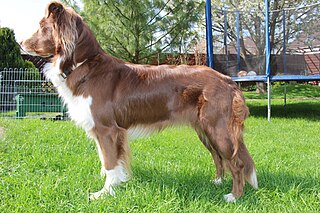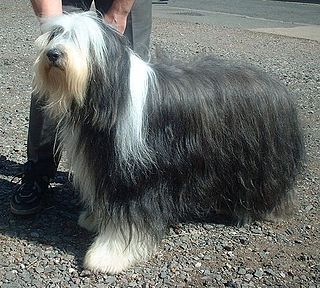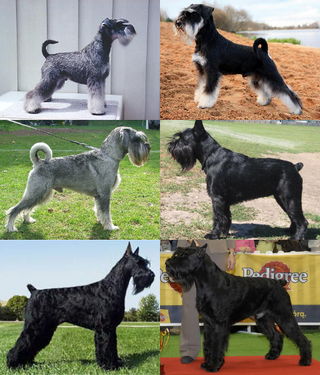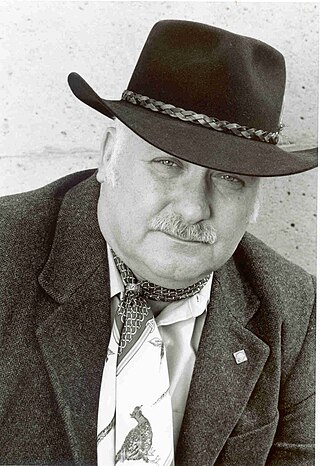
The Siberian Husky is a medium-sized working sled dog breed. The breed belongs to the Spitz genetic family. It is recognizable by its thickly furred double coat, erect triangular ears, and distinctive markings, and is smaller than the similar-looking Alaskan Malamute.

The English Setter is a medium-size breed of dog. It is part of the setter group, which includes the red Irish Setters, Irish Red and White Setters, and black-and-tan Gordon Setters. The mainly white coath as long silky fringes on the back of the legs, under the belly and on the tail. The coat features flecks of colour, and the different colour varieties are referred to as 'belton'.

The German Shepherd, also known in Britain as an Alsatian, is a German breed of working dog of medium to large size. The breed was developed by Max von Stephanitz using various traditional German herding dogs from 1899.

The American Kennel Club (AKC) is a registry of purebred dog pedigrees in the United States. In addition to maintaining its pedigree registry, this kennel club also promotes and sanctions events for purebred dogs, including the Westminster Kennel Club Dog Show, an annual event which predates the official forming of the AKC, the National Dog Show and the AKC National Championship. The AKC is a non-member partner with the Fédération Cynologique Internationale. The AKC recognizes 200 dog breeds, as of 2022.

The Border Collie is a British breed of herding dog of the collie type of medium size. It originates in the region of the Anglo-Scottish border, and descends from the traditional sheepdogs once found all over the British Isles. It is kept mostly as a working sheep-herding dog or as a companion animal. It competes with success in sheepdog trials. It has been claimed that it is the most intelligent breed of dog.

The Shetland Sheepdog, also known as the Sheltie, is a breed of herding dog that originated in the Shetland Islands of Scotland. It was formally recognized by The Kennel Club in 1909. It was originally called the Shetland Collie, but this caused controversy amongst Rough Collie breeders of the time, so the name was changed. It is a small dog, clever, vocal, willing to please, and trustworthy.

The Boxer is a medium to large, short-haired dog breed of mastiff-type, developed in Germany. The coat is smooth and tight-fitting; colors are fawn, brindled, or white, with or without white markings. Boxers are brachycephalic, have a square muzzle, mandibular prognathism, very strong jaws, and a powerful bite ideal for hanging on to large prey. The Boxer was bred from the Old English Bulldog and the now extinct Bullenbeisser, which became extinct by crossbreeding rather than by a decadence of the breed. The Boxer is a member of both The Kennel Club and American Kennel Club (AKC) Working Group.

The Miniature Schnauzer is a breed of small dog of the Schnauzer type that originated in Germany in the mid-to-late 19th century. Miniature Schnauzers may have been developed from the smallest specimens of the Standard Schnauzer, or crosses between the standard and one or more smaller breeds such as the Affenpinscher, Miniature Pinscher, and Poodles, as farmers bred a small dog that was an efficient ratting dog. They are described as "spunky" but aloof dogs, with good guarding tendencies without some guard dogs' predisposition to bite. Miniature Schnauzers are recognized in four colors internationally: solid black, black and silver, salt and pepper, and white.

The Australian Cattle Dog, or simply Cattle Dog, is a breed of herding dog developed in Australia for droving cattle over long distances across rough terrain. This breed is a medium-sized, short-coated dog that occurs in two main colour forms. It has either red or black hair distributed fairly evenly through a white coat, which gives the appearance of a "red" or "blue" dog.

Collies form a distinctive type of herding dogs, including many related landraces and standardized breeds. The type originated in Scotland and Northern England. Collies are medium-sized, fairly lightly-built dogs, with pointed snouts. Many types have a distinctive white color over the shoulders. Collies are very active and agile, and most types of collies have a very strong herding instinct. Collie breeds have spread through many parts of the world, and have diversified into many varieties, sometimes mixed with other dog types.

The Australian Shepherd is a breed of herding dog from the United States. The name of the breed is technically a misnomer, as it was developed in California in the 19th century. It is believed to have its origins in sheepdog breeds from northwest Spain, as well as collies imported, alongside sheep, from Australia and New Zealand; the breed reportedly took its name from this trade. Originally used solely as a herding dog, the Australian Shepherd has become one of the most popular companion dog breeds in North America.

The Poodle, called the Pudel in German and the Caniche in French, is a breed of water dog. The breed is divided into four varieties based on size, the Standard Poodle, Medium Poodle, Miniature Poodle and Toy Poodle, although the Medium Poodle is not universally recognised. They have a distinctive thick, curly coat that comes in many colors and patterns, with only solid colors recognized by breed registries. Poodles are active and intelligent, and are particularly able to learn from humans. Poodles tend to live 10–18 years, with smaller varieties tending to live longer than larger ones.

The Bearded Collie, or Beardie, is a herding breed of dog once used primarily by Scottish shepherds, but now mostly a popular family companion.

The Nova Scotia Duck Tolling Retriever is a medium-sized gundog bred primarily for hunting. It is often referred to as a "toller". It is the smallest of the retrievers, and is often mistaken for a small Golden Retriever. Tollers are intelligent, eager to please, alert, and energetic. The name "toller" is derived from their ability to lure waterfowl within gunshot range. The breed originated in Yarmouth County, Nova Scotia, Canada. The American Kennel Club ranks the toller as the 87th most popular dog breed.

A Schnauzer is a dog breed type that originated in Germany from the 14th to 16th centuries. The term comes from the German word for "snout" and means colloquially "moustache", or "whiskered snout", because of the dog's distinctively bearded snout. Initially it was called Wire-Haired Pinscher, while Schnauzer was adopted in 1879.
Dog intelligence or dog cognition is the process in dogs of acquiring information and conceptual skills, and storing them in memory, retrieving, combining and comparing them, and using them in new situations.

The Lhasa Apso is a non-sporting dog breed originating in Tibet. Traditionally the breed has been used as an interior watchdog.

A companion dog is a dog which is not primarily a working dog but a pet. The primary function of a companion dog is not to perform a useful job but to provide companionship to humans. A companion dog can also be called an emotional support animal and is used to help people with mental health disabilities cope with symptoms. Most dogs can be companions, including many working dog breeds such as retrievers, who are enjoyed primarily for their friendly nature as a pet. Most toy dog breeds are used only for the pleasure of their company, not as workers. The American Kennel Club also offers a Companion dog title for judged dog obedience competitions.

The Dobermann is a German breed of medium-large domestic dog of pinscher type. It was originally bred in Thuringia in about 1890 by Louis Dobermann, a tax collector. It has a long muzzle and – ideally – an even and graceful gait. The ears were traditionally cropped and the tail docked, practices which are now illegal in many countries.

Stanley Coren is a psychology professor, neuropsychological researcher and writer on the intelligence, mental abilities and history of dogs. He works in research and instructs in psychology at the University of British Columbia in Vancouver, British Columbia. He writes for Psychology Today in the feature series Canine Corner.



















